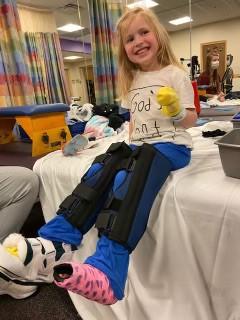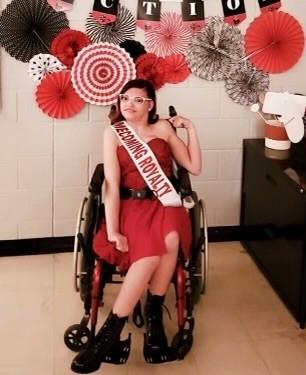Bright Futures
Articles and Updates from Phoenix Children's
“When you have a baby, you have all of these dreams for them. But when you hear the diagnosis of cerebral palsy, you realize you have to change those dreams. What I want to say is that our family has learned so much from our journey. There is a whole new world that’s amazing and beautiful. It’s hard, but it really is beautiful.”
- Jessica Holemon, mother of 6-year-old Abigail “Abby” Holemon
Wide-Ranging Effects, Life-Long Journeys
More than 1 million Americans are living with cerebral palsy (CP), the most common physical disability of childhood. Caused by brain injury that occurs before, during or after birth, or in some cases by certain genetic mutations, CP primarily affects muscle tone, movement and coordination. It can also impact talking, breathing and eating.
One in two people with CP lives in chronic pain; one in three cannot walk, and one in five cannot talk.
Yet the stories of perseverance, resilience and achievement among those living with cerebral palsy are inspiring, says Michael Kruer, MD, director, Pediatric Movement Disorders Program at Phoenix Children’s, which offers the only comprehensive program of its kind in the Southwest.
March is Cerebral Palsy Awareness Month, and Dr. Kruer and his team want to share two powerful patient stories and convey three important messages.
- Early diagnosis can change the course of care and health. Cerebral palsy can be diagnosed as early as six months of age, and the earlier patients are evaluated through a comprehensive program like the one at Phoenix Children’s, the greater the opportunity for effective treatment.
- Adolescents with cerebral palsy can also benefit from a comprehensive evaluation. While cerebral palsy is not a progressive condition – meaning it doesn’t worsen over time – it can create new issues as a child grows. Parents of adolescent children with CP who may be experiencing a decline in function should seek an evaluation.
“We know much more than we did even 10 years ago, and we may be able to offer new therapy and treatment options for older children and teens,” says Laura Wilner, MD, division chief, Physical Medicine and Rehabilitation at Phoenix Children’s and medical director, Cerebral Palsy Section.
- The resources available at Phoenix Children’s and through the Cerebral Palsy Research Network (CPRN) are extensive. Not only do patients have access to the team of experts in all specialties at the hospital, but Phoenix Children’s is also the genetics hub for the nationwide CPRN, which pools data from across the country to research and develop gold standards for cerebral palsy diagnosis and treatment.
Abby and Makayla: Resilience in Action
The stories of Abigail “Abby” Holemon and Makayla Rodriquez-Montoya highlight the range of cerebral palsy’s causes, effects and impacts on families.
Almost 7, Abby is an outgoing young girl who can walk and talk, and fully engages with her family and friends. In her short life, however, she has also undergone several extensive surgeries to relieve painful spasticity in her left leg and reposition her left tibia (one of the two bones in the lower leg) to improve her walk.
At 19, Makayla is set to achieve a major milestone. Although she cannot talk, she will graduate from high school this spring and hopes to take a job with the company that developed the eye-tracking technology that helps her communicate. Makayla navigates primarily in a wheelchair. At home, however, she walks on her knees – her most comfortable position.
The mothers of both Abby and Makayla – Jessica Holemon and Felisha Rodriquez – say their worlds turned upside down with the CP diagnosis, but they also describe the amazing new worlds they have discovered since. Both Abby and Makayla are under the care of the Cerebral Palsy Program at Phoenix Children’s.
Cerebral palsy caused painful leg spasticity for Abby Holemon, an outgoing 6-year-old, but after complex selective dorsal rhizotomy surgery, she walks more comfortably and even sleeps through the night.
Abby’s Story: SDR Surgery Relieves Pain and Spasticity
At 26 weeks, Abby suffered a stroke in utero (before her birth), but no one knew until her first birthday, when her developmental delays became clear. She was rolling over only to one side and was not sitting up well or pulling herself up to a standing position. After extensive evaluations, physicians delivered the news: a cerebral palsy diagnosis with left-sided spasticity and weakness.
“Spasticity is like having a charley horse all the time, and it is painful and tiring,” says Jessica. “It can also limit the growth of your bones. Abby is in regular physical therapy and does swim lessons, horse therapy, even gymnastics – all to help her stretch and strengthen her legs.”
She has also had three significant surgeries. The first came in June 2020. Her neurosurgeon, David Shafron, MD, recommended SDR – selective dorsal rhizotomy – which involves identifying and then cutting the nerve roots causing her spasticity.
“Before surgery, we went through an extensive evaluation at the hospital’s Complex Tone Management Clinic, with four doctors reviewing and discussing her case,” says Jessica. “We chose the surgery because we really hoped it would relieve some of Abby’s pain and fatigue.
“We are so happy we did,” Jessica continues. “Abby never slept well before because of the pain, but after the surgery – for the first time in her life – she began to sleep through the night. She did have to relearn to walk, and we were in the hospital’s Inpatient Rehabilitation Unit for 21 days during the height of COVID. But her recovery and improvements have been wonderful.”
Since then, Abby has had heel cord lengthening surgery and a tibia rotation this past January. Before the most recent procedure, she was evaluated in the hospital’s Motion Analysis Lab, where physical therapists and engineers studied her movement patterns and muscle activity to create a customized treatment plan.
Appropriately this month – Cerebral Palsy Awareness Month – Abby will be able to remove her cast and be fitted for a new ankle-foot orthotic, a special device that supports her walk.
“Abby is so strong, brave, resilient and kind,” says Jessica. “We learn from her every day. And we are so grateful to have the resources of Phoenix Children’s. They recognize that every child is unique, and they have been so supportive of Abby and our entire family.”
Makayla Rodriquez-Montoya, who has never let cerebral palsy hold her back, enjoyed a special night as a Homecoming Princess at Williams Field High School last fall. She will graduate this spring.
Makayla’s Story: Deep Brain Stimulation Relieves Pain, Improves Quality of Life
Makayla’s cerebral palsy, which is severe, was diagnosed early because she suffered a traumatic injury at birth. Until age 15, Makayla and her family lived in New Mexico. But when Felisha realized her daughter needed additional resources, she did extensive research and found Dr. Kruer and Phoenix Children’s. The family moved to Arizona.
“Makayla is my world, and I knew she needed more,” says Felisha. “Her dystonia (involuntary or uncontrolled muscle contraction) was so painful. It was very difficult. But when we met with Dr. Kruer, he was very encouraging. He believed Makayla was a candidate for deep brain stimulation (DBS), so Makayla underwent the extensive evaluations she needed before the procedure could be done.”
In 2020, Makayla was cleared for DBS – which proved to be a life-changing surgery. Guided by advanced imaging technology, her team of traditional and stereotactic neurosurgeons implanted tiny electrodes on thin, flexible wires into areas of her brain that controlled her movement. They also placed a small pacemaker-like device called a neurostimulator under her skin just below her collar bone. Once programmed and set by a movement disorders neurologist, the device delivers steady, low pulses that help manage the abnormal brain rhythms causing the involuntary muscle movement.
“We have seen huge improvements – at least they are huge to us,” says Felisha. “Most importantly, she no longer has pain. She can open up her hands and get into certain positions on the floor to be more comfortable. Every three months we visit Phoenix Children’s, and sometimes they ‘give her some juice’ as we call it – adjusting the frequency or strength of the stimulation. It’s made an amazing difference.”
Like Abby, Makayla remains in constant therapy – physical, occupational and speech – which she tackles enthusiastically.
“As a parent who wants the best for her child, I can tell you that it’s hugely important to have all of these resources available to us through Phoenix Children’s,” says Felisha. “Everything we need is there, and that helps put my mind at ease.”
Both Felisha and Jessica offer words for advice for other parents of children with cerebral palsy:
- Take care of yourself because your child and family need you.
- Choose what is best for you and your family with the guidance of the experts. No two situations are the same, so find what works for you.
- Celebrate the joys, and embrace the beauty.

